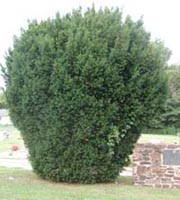Resource Library
Plant of the Week: Yew, Pacific
The University of Arkansas System Division of Agriculture does not promote, support or recommend plants featured in "Plant of the Week." Please consult your local Extension office for plants suitable for your region.
Plant of the Week
Pacific Yew
Latin: Taxus brevifolia

For most of us cancer is like distant flashes of lightning on a July night on the prairies - sudden bursts of light but no sound. Not until it strikes close enough to rattle the windows of our house do we sit up and take notice.
As the doctor utters those three simple words, everything changes and the patient and family find themselves immersed in the emotional and highly technical field of the oncologist. Cancer treatment once fell primarily in the realm of the surgeon, but today an array of treatment options is available. Of these, taxol has emerged as a superstar in the War on Cancer that President Nixon declared back in 1971.
Taxol is a drug first extracted from the bark of the Pacific Yew, Taxus brevifolia. This species, one of three yews native to North America, occurs as an understory tree in the mountains of the Pacific Northwest from southern Alaska to northern California and inland to Montana.
In the great Northwest where forest giants like the Sitka spruce and Douglas fir dominate the landscape and mentality, the 30-foot tall Pacific yew was considered a trash tree fit for little more than fence posts, an occasional long bow, or -- more often -- the slash pile for burning.
Taxol’s discovery and development traces its start to the 1950s when two plants - periwinkle used in treating leukemia and mayapple used for vaginal warts -- were shown to be effective in clinical trials. It was assumed that other plants might exist that had similar properties, so the National Cancer Institute (NCI) formed an agreement with the USDA in the early 1960s to screen plants for anti-tumor potential.
In 1962, Arthur Barclay, a Harvard trained botanist, was in the Pacific Northwest where he collected a number of plants for the NCI-USDA screening program. In the collection was bark, twigs and needles of Taxus brevifolia.
The initial screening program was a non-focused effort, casting as wide a net as possible to look at all manner of plants for anti-tumor properties. With the clarity of hindsight, this scatter gun approach was an inefficient means of finding the few plants that had biological activity. In the 20 years the screening program was conducted, 114,000 crude extracts were tested from an estimated 15,000 plants from throughout the world. Of this number, five were carried into advanced stages of testing but only taxol made it all the way through the approval process.
The first hint of success came in 1964, when the crude extract from the Pacific yew was purified and tested in the tumor screening project run by Munroe Wall in North Carolina. Wall, a chemist, went on to name the compound he had isolated taxol. Twenty years would elapse before the initial promising results with taxol moved to clinical trials with cancer patients. As the trials showed promise, the abysmally low yield of taxol began to cause supply problems. The Pacific yew did not occur in pure stands but was scattered in the forest and removing the bark killed the trees. As environmentalists weighed in on the issue as larger bark harvests occurred, it became apparent that another solution was needed to the supply problem.
In 1989, the NCI announced it was ready to seek a partner to commercialize the drug they had developed over the past several decades. According to critics of the deal that was finally struck, the draft version of the announcement seeking a partner contained verbiage spelling out that the federal government would receive a portion of the income generated by the sale of the drug once it was marketed. But when published in the Federal Register all reference to sharing the proceeds was inexplicably eliminated.
Bristol-Myers Squibb was accepted as the partner for the NCI. To the chagrin of the critics of the deal which ultimately spawned three congressional hearings, the rights to produce and market the drug moved to the third largest drug company in the world and taxol became Taxol. By this time, it was known that dried leaves and twigs could be used for extraction and the company switched to using biomass from southern Europe. In 1998, sales of this one drug amounted to $1.2 billion.
The Pacific yew is not commonly seen in the landscape trade. The yews we grow in northern Arkansas are primarily selections of Taxus x media, a hybrid of the English yew and the Japanese yew. This yew too contains taxol and efforts were half-heartedly tried to extract the drug from foliage of nursery grown plants, but the NCI’s fixation on bark seems to have prevented this from occurring.
By: Gerald Klingaman, retired
Extension Horticulturist - Ornamentals
Extension News - February 20, 2004
The University of Arkansas System Division of Agriculture does not maintain lists of retail outlets where these plants can be purchased. Please check your local nursery or other retail outlets to ask about the availability of these plants for your growing area.